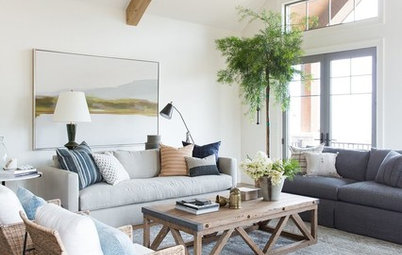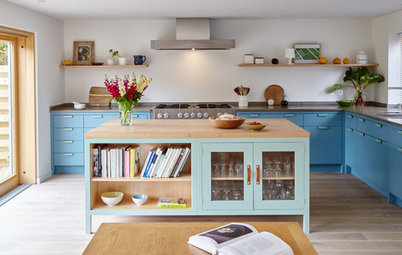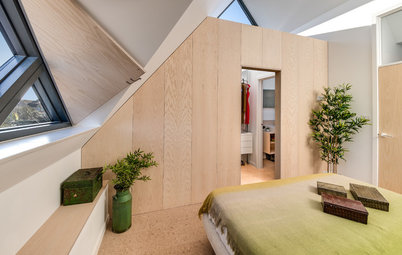How to Retrofit Healthy Ventilation into Your Home
Want to fit a mechanical ventilation system into your existing property? These expert tips will help you get started
If you’d like clean, fresh air circulating around your home at a comfortable temperature, it’s worth considering installing a mechanical ventilation with heat recovery (MVHR) system. These consist of a unit and ducts that extract stale air from your home and replace it with fresh air. They’re a common addition to new-build properties, but just how easy is it to retrofit one into an older building? As part of our comprehensive Sustainable Renovation Planning guide, three experts give us the lowdown.
Professional advice from: Paul Testa of HEM Architects; Kit Knowles of Ecospheric; Becky Wootton of Architecture for London
Professional advice from: Paul Testa of HEM Architects; Kit Knowles of Ecospheric; Becky Wootton of Architecture for London
What type of ventilation system do you recommend?
Our experts suggest installing a mechanical ventilation with heat recovery unit in your home. The name is a bit of a mouthful, so it’s generally shortened to MVHR.
These systems extract warm air from inside the home and cool air from outside, passing both through a heat exchanger box. So before the inside air is piped out, the heat is transferred to the incoming, filtered fresh air, bringing it to a regulated temperature before it’s released into the home. A summer bypass control can be used in warmer months when the heat exchanger isn’t needed.
Paul explains that the air is extracted from wet rooms, such as kitchens and bathrooms, and the filtered air is put back in via ducts and air terminals throughout the house. “Although the heat is taken out of the outgoing air and put back into the incoming air, the air itself doesn’t mix,” he says. “Just the heat is transferred and the warmed incoming air is fresh.”
“The box filters out all of the particulates, recovers outgoing heat, and puts fresh, warm air back into the house just where it’s needed,” Kit says. “It also helps to control humidity, which in turn helps to control nasty pathogens.”
“An MVHR system, working in tandem with good levels of insulation and airtightness, will create a healthy home that’s far more comfortable to live in, more efficient, and cost-effective to heat,” Becky Wootton says.
Our experts suggest installing a mechanical ventilation with heat recovery unit in your home. The name is a bit of a mouthful, so it’s generally shortened to MVHR.
These systems extract warm air from inside the home and cool air from outside, passing both through a heat exchanger box. So before the inside air is piped out, the heat is transferred to the incoming, filtered fresh air, bringing it to a regulated temperature before it’s released into the home. A summer bypass control can be used in warmer months when the heat exchanger isn’t needed.
Paul explains that the air is extracted from wet rooms, such as kitchens and bathrooms, and the filtered air is put back in via ducts and air terminals throughout the house. “Although the heat is taken out of the outgoing air and put back into the incoming air, the air itself doesn’t mix,” he says. “Just the heat is transferred and the warmed incoming air is fresh.”
“The box filters out all of the particulates, recovers outgoing heat, and puts fresh, warm air back into the house just where it’s needed,” Kit says. “It also helps to control humidity, which in turn helps to control nasty pathogens.”
“An MVHR system, working in tandem with good levels of insulation and airtightness, will create a healthy home that’s far more comfortable to live in, more efficient, and cost-effective to heat,” Becky Wootton says.
How much does it cost to buy and install an MVHR system?
“There’s a wide range of MVHR options, from single units that serve one room to larger units that ventilate a whole house,” Becky says. She explains that single units usually cost about £300.
“There are two main factors that affect performance – fan power and heat recovery,” Kit says. “Previously, devices would be good at one but not the other. Nowadays, you can find units that are the best of both worlds.”
If you have a competent designer who takes the time to survey the site in person, rather than just guessing from plans, and an experienced MVHR installer, you could probably get the whole system installed in two days,” Kit continues. “Current costs range between £5,000 and £8,000 for a house with three to five bedrooms, depending on the quality of the design. The MVHR units on their own cost about £2,000 to £3,000 each and the additional fees would be for design and installation.”
“There’s a wide range of MVHR options, from single units that serve one room to larger units that ventilate a whole house,” Becky says. She explains that single units usually cost about £300.
“There are two main factors that affect performance – fan power and heat recovery,” Kit says. “Previously, devices would be good at one but not the other. Nowadays, you can find units that are the best of both worlds.”
If you have a competent designer who takes the time to survey the site in person, rather than just guessing from plans, and an experienced MVHR installer, you could probably get the whole system installed in two days,” Kit continues. “Current costs range between £5,000 and £8,000 for a house with three to five bedrooms, depending on the quality of the design. The MVHR units on their own cost about £2,000 to £3,000 each and the additional fees would be for design and installation.”
How disruptive is it to retrofit an MVHR system?
“The biggest issues are working out where to install the main unit, and then how to hide the duct runs around the house,” Becky says. “A whole house MVHR system needs to be designed by a specialist to ensure the duct runs are as short and efficient as possible, and that the unit is sized properly.”
“If you have voids behind fitted wardrobes or kitchen cabinets, or have connected or stacked bathrooms, you can do it with little disruption,” Kit says.
Becky also highlights one-room units, which are simple to install in a new extension. “This means you don’t have to worry about where to store a large central unit, or how to run the ducts around your house,” she says. “[A unit] just needs to be installed on an external wall, and can deliver fresh, warmed air directly into the room. They are more efficient than traditional mechanical extract fans.
“As well as installing the MVHR unit, you’ll also want to ensure the house is as airtight as possible, so it can operate as efficiently as possible,” Becky adds. “This may mean upgrading any draughty windows and doors, and filling cracks and gaps in walls and floors.”
More: Is This the UK’s Greenest Victorian House?.
“The biggest issues are working out where to install the main unit, and then how to hide the duct runs around the house,” Becky says. “A whole house MVHR system needs to be designed by a specialist to ensure the duct runs are as short and efficient as possible, and that the unit is sized properly.”
“If you have voids behind fitted wardrobes or kitchen cabinets, or have connected or stacked bathrooms, you can do it with little disruption,” Kit says.
Becky also highlights one-room units, which are simple to install in a new extension. “This means you don’t have to worry about where to store a large central unit, or how to run the ducts around your house,” she says. “[A unit] just needs to be installed on an external wall, and can deliver fresh, warmed air directly into the room. They are more efficient than traditional mechanical extract fans.
“As well as installing the MVHR unit, you’ll also want to ensure the house is as airtight as possible, so it can operate as efficiently as possible,” Becky adds. “This may mean upgrading any draughty windows and doors, and filling cracks and gaps in walls and floors.”
More: Is This the UK’s Greenest Victorian House?.
Where do the duct pipes go?
Becky explains that you’ll require a supply duct to the habitable spaces, such as bedrooms and living rooms, and an extract duct from every wet room, such as the bathroom, kitchen and utility room. “The ducts are rigid (metal) or semi-rigid (plastic), typically around 100-150mm in diameter,” he says.
“If you can install the ducts between floor and ceiling joists, make the most of this, but some boxing out is often required,” Becky continues. “We try to hide them in joinery or in service spaces. If we need to create service zones in ceilings, we do this in bathrooms and hallways, rather than the main rooms.”
Kit also highlights a manifold system, where lots of little pipes come off one larger one. “So rather than having one pipe, you have a bundle of pipes, one leading to each room,” he says. “Each of the pipes can be 75mm in diameter. You can fit a cone to the end of the pipe and pull it through a void without having to remove the finishes. This has some major benefits for retrofit.”
Becky explains that you’ll require a supply duct to the habitable spaces, such as bedrooms and living rooms, and an extract duct from every wet room, such as the bathroom, kitchen and utility room. “The ducts are rigid (metal) or semi-rigid (plastic), typically around 100-150mm in diameter,” he says.
“If you can install the ducts between floor and ceiling joists, make the most of this, but some boxing out is often required,” Becky continues. “We try to hide them in joinery or in service spaces. If we need to create service zones in ceilings, we do this in bathrooms and hallways, rather than the main rooms.”
Kit also highlights a manifold system, where lots of little pipes come off one larger one. “So rather than having one pipe, you have a bundle of pipes, one leading to each room,” he says. “Each of the pipes can be 75mm in diameter. You can fit a cone to the end of the pipe and pull it through a void without having to remove the finishes. This has some major benefits for retrofit.”
How big is the device unit and where would I store it?
“Centralised units for a family house are somewhere in the region of 800 x 700 x 600mm,” Becky says. “But you also need space around them for the ducts coming in and out of the unit, and access for maintenance.”
“They can work in most places, but they’re better placed inside the thermal envelope [the insulated walls and roof] than out,” Kit says, “and where pipework can be minimised, such as the first floor airing cupboard near an external wall.”
“If you have a loft space, this can be a good option for a retrofit, or you may be able to find space in a utility room or large storage cupboard,” Becky says. “The smaller, one room units take up far less space and can look like a standard mechanical extract fan.”
“Centralised units for a family house are somewhere in the region of 800 x 700 x 600mm,” Becky says. “But you also need space around them for the ducts coming in and out of the unit, and access for maintenance.”
“They can work in most places, but they’re better placed inside the thermal envelope [the insulated walls and roof] than out,” Kit says, “and where pipework can be minimised, such as the first floor airing cupboard near an external wall.”
“If you have a loft space, this can be a good option for a retrofit, or you may be able to find space in a utility room or large storage cupboard,” Becky says. “The smaller, one room units take up far less space and can look like a standard mechanical extract fan.”
How easy is it to maintain an MVHR system?
“MVHR is typically maintenance free in all ways bar [having to periodically replace] two filters that protect the heat exchanger,” Kit says. “Typically, manufacturers suggest annual replacement of filters. However, with regular vacuuming of the filters (60 seconds once every three months), you can extend the life of the filter to several years.
“Remember, up to a point, filters improve at blocking fine particles as they get blocked up,” he continues. “The issue lies in the ever-increasing power demand, as the air flow becomes restricted. At some point, if left without maintenance, the system would fail to deliver adequate air flow to the building. A replacement set of filters typically costs £25 to £60, depending on the model.”
Tell us…
Would you consider installing an MVHR system in your home? Share your thoughts in the Comments.
“MVHR is typically maintenance free in all ways bar [having to periodically replace] two filters that protect the heat exchanger,” Kit says. “Typically, manufacturers suggest annual replacement of filters. However, with regular vacuuming of the filters (60 seconds once every three months), you can extend the life of the filter to several years.
“Remember, up to a point, filters improve at blocking fine particles as they get blocked up,” he continues. “The issue lies in the ever-increasing power demand, as the air flow becomes restricted. At some point, if left without maintenance, the system would fail to deliver adequate air flow to the building. A replacement set of filters typically costs £25 to £60, depending on the model.”
Tell us…
Would you consider installing an MVHR system in your home? Share your thoughts in the Comments.
























To keep the air in your home healthy, it’s important to ensure the building is well ventilated. Of course, you could just open the windows, but our experts say this isn’t always effective.
“Having a purposefully designed ventilation system is a must to get rid of pollutants in the air as well as introducing fresh air to breathe,” Paul Testa says. “It might be useful to open all the windows, but, if it’s cold outside, a lot of heat energy from the house will be wasted during ventilation.”
“The reverse situation could be [as bad] – keeping all the windows shut and draught-proofing well,” he adds. “Any pollutants from off-gassing carpets, for example, or from cooking cannot escape. In the winter, neither of these extremes is an effective way of ventilating a house and getting good air quality.”
“People expect to pay for things like insulation, but don’t think about ventilation,” Kit Knowles says. “It’s often low on the list of priorities, but in fact it’s the foundation upon which the main sustainable building strategies are based.”
Find a qualified local contractor in the Houzz Professionals Directory.